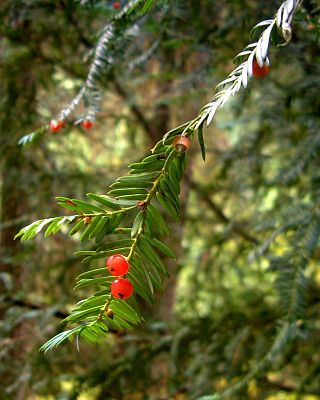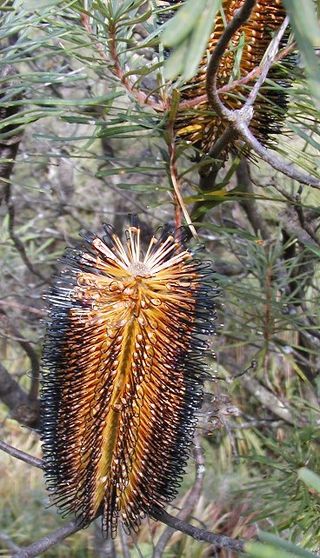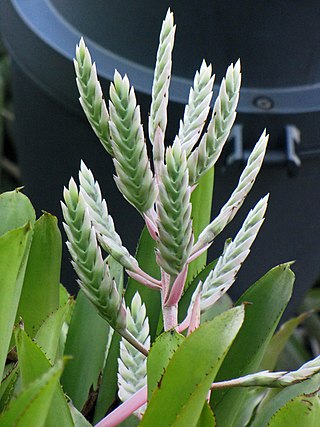
Juniperus communis, the common juniper, is a species of small tree or shrub in the cypress family Cupressaceae. An evergreen conifer, it has the largest geographical range of any woody plant, with a circumpolar distribution throughout the cool temperate Northern Hemisphere.

Taxus brevifolia, the Pacific yew or western yew, is a species of tree in the yew family Taxaceae native to the Pacific Northwest of North America. It is a small evergreen conifer, thriving in moisture and otherwise tending to take the form of a shrub.

Banksia nutans, commonly known as nodding banksia, is a species of shrub native to the south coast of Western Australia in the genus Banksia. Growing to a metre (3 ft) tall, it has pale blue-green fine-leaved foliage and unusual purple-brown inflorescences which hang upside down rather than grow upright like most other banksias.

Banksia sphaerocarpa, commonly known as the fox banksia or round-fruit banksia, is a species of shrub or tree in the plant genus Banksia. It is generally encountered as a 1–2 m (3.3–6.6 ft) high shrub, and is usually smaller in the north of its range. This species has narrow green leaves, and brownish, orange or yellow round flower spikes which may be seen from January to July. It is widely distributed across the southwest of Western Australia, growing exclusively in sandy soils. It is usually the dominant plant in scrubland or low woodland. It is pollinated by, and is a food source for, birds, mammals, and insects.

Banksia armata, commonly known as prickly dryandra, is a species of often sprawling shrub that is endemic to Western Australia. It has deeply serrated leaves with sharply pointed lobes and spikes of about 45 to 70 yellow flowers.

Banksia fraseri is a species of shrub that is endemic to Western Australia. It has hairy stems, broadly linear pinnatisect leaves with between four and eighteen sharply-pointed lobes on each side, between eighty and one hundred pink to cream-coloured flowers and wedge-shaped follicles.

Banksia tenuis is a species of shrub that is endemic to the southwest of Western Australia. It has pinnatifid, serrated or smooth-edges leaves, golden brown and cream-coloured flowers in heads of about fifty-five and glabrous, egg-shaped follicles.

Banksia spinulosa var. collina is a shrub that grows along the east coast of Australia, in Queensland and New South Wales. Commonly known as Hill Banksia or Golden Candlesticks, it is a taxonomic variety of B. spinulosa. It is a popular garden plant widely sold in nurseries.

Richeria grandis is a tree species in the family Phyllanthaceae which ranges from the Lesser Antilles to South America. The species is reputed to have aphrodisiac properties.

Roupala is a Neotropical genus of woody shrubs and trees in the plant family Proteaceae. Its 34 species are generally found in forests from sea level to 4000 m altitude from Mexico to Argentina.

Banksia spinulosa var. spinulosa is a shrub that grows along the east coast of Australia, in Queensland and New South Wales.

Banksia spinulosa var. cunninghamii, sometimes given species rank as Banksia cunninghamii, is a shrub that grows along the east coast of Australia, in Victoria and New South Wales. It is a fast-growing non-lignotuberous shrub or small tree infrequently cultivated.

Bellendena montana, commonly known as mountain rocket, is a species of low-growing multi-stemmed shrub in the plant family Proteaceae. It is endemic to high-altitude subalpine and alpine regions in Tasmania, Australia. The prominent white flower spikes appear over summer, followed by small bright red or yellow fruit in late summer and autumn.

Roystonea oleracea, sometimes known as the Caribbean royal palm, palmiste, imperial palm or cabbage palm, is a species of palm which is native to the Lesser Antilles, Colombia, Venezuela, and Trinidad and Tobago. It is also reportedly naturalized in Guyana and on the islands of Mauritius and Réunion in the Indian Ocean.

Heliconia psittacorum is a perennial herb native to the Caribbean and South America. It is considered native to French Guiana, Guyana, Suriname, Venezuela, Colombia, Bolivia, Brazil, Paraguay, Panama and Trinidad and Tobago. It is reportedly naturalized in Gambia, Thailand, Puerto Rico, Hispaniola, Jamaica and the Lesser Antilles. It is often cultivated as a tropical ornamental plant in regions outside its native range.

Aechmea dichlamydea is a species of bromeliad in the genus Aechmea. This species is native to Venezuela and to Trinidad and Tobago.

Oreocallis is a South American plant genus in the family Proteaceae. There is only one species, Oreocallis grandiflora, which is native to mountainous regions in Peru and Ecuador.

Agastachys odorata, commonly known as the white waratah or fragrant candlebush, is the sole member of the genus Agastachys in the protea family. It is an evergreen shrub to small tree and is endemic to the heaths and button grass sedgelands of western Tasmania.
Parinari campestris is a species of tree in the plant family Chrysobalanaceae which is native to Trinidad, the Guianas, Venezuela and Brazil. It is reputed to have aphrodisiac properties.





















